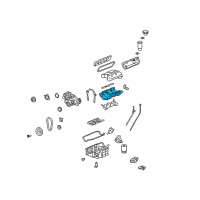< Back ×
2007 Buick Terraza Intake Manifold
My Vehicle Change Vehicle
2007 Buick Terraza
< Back to View All
Air Filters & Intake Systems
- Department
- Prices
- Product Specifications
- Notes: Terraza, Uplander; 3.9l
- Other Names: Intake Manifold, Intake Plenum
- Item Dimensions: 20.4 x 14.5 x 9.4 inches
- Item Weight: 10.90 Pounds
- Fitment Type: Direct Replacement
- Part Description: 2007 Buick Terraza Manifold Asm, Lower Intake
Vehicle Fitment- 2007 Buick Terraza | CX, CXL | 6 Cyl 3.9 L FLEX, 6 Cyl 3.9 L GAS
FAQ for Intake Manifold Repair
Q: How to remove the Lower Intake Manifold?
A:
You can remove the coolant crossover pipe, the upper intake manifold, the left valve rocker arm cover, the right valve rocker arm cover, the engine coolant temperature (ECT) electrical connector, the fuel feed line from the fuel rail, the connector position assurance (CPA) retainer, the engine harness electrical connector, the fuel injector harness connector bracket bolt from the intake manifold, the camshaft position (CMP) sensor electrical connector, the fuel injector rail bolts, the fuel rail, the lower intake manifold bolts, the lower intake manifold, the valve rocker arm bolts, the valve rocker arms, the push rods, and the lower intake manifold gaskets and seals, clean the lower intake manifold gasket and seal surfaces on the cylinder heads and the engine block, the gasket and seal surfaces on the lower intake manifold with degreaser, and remove all the loose room temperature vulcanizing sealer (RTV).
By Bob
GM Specialist
01/11/2022Q: How to remove the Intake Manifold Tuning Valve?
A:
You can remove the intake manifold cover, the engine harness electrical connector, the power steering pump, the intake manifold tuning valve bolts, and the intake manifold tuning valve.
By Bob
GM Specialist
01/11/2022Q: How to install the Intake Manifold?
A:
You can install the inlet manifold tuning valve, and bolts, the EVAP canister purge solenoid valve seal for damage, the EVAP canister purge solenoid valve, the MAP sensor, the throttle body and bolts/studs, the upper intake manifold bolts, the ignition coil, the bracket from the generator to the intake manifold, the bolt connecting the generator, the nut connecting the generator bracket to the upper intake manifold, the inlet and outlet pipe to the studs, the heater inlet and outlet pipe nuts, the left side spark plug wires, the left side spark plug wires to the spark plugs, the left side spark plug wires to the ignition control module, the air cleaner outlet duct, the engine harness electrical connector, the engine harness electrical connectors, the brake booster vacuum hose to the intake manifold, the PCV foul air tube, the PCV fresh air tube, the cooling system, the intake manifold cover, and the negative battery cable.
By Bob
GM Specialist
01/11/2022Q: How to install the Intake Manifold Tuning Valve?
A:
You can apply GM P/N 1051344 (Canadian P/N 993037) to the nose of the valve blade, install the intake manifold tuning valve, the intake manifold tuning valve bolts, the power steering pump, the engine harness electrical connector, and the intake manifold cover.
By Bob
GM Specialist
01/11/2022Q: How to install the Lower Intake Manifold?
A:
You can install the lower intake manifold gaskets and seals, the ends of the push rods, the push rods in their original location, the rocker arm friction surfaces, the valve rocker arms in their original positions, the valve rocker arm bolts, sealer to the lower intake manifold bolt threads, the lower intake manifold bolts, the fuel rail, the fuel injector O-rings, the injector nozzles into the lower intake manifold injector bores, the fuel injector rail bolts, the CMP sensor electrical connector, the fuel injector harness connector bracket to the intake manifold, the fuel injector harness connector bracket bolt, the engine harness electrical connector, the CPA retainer, the fuel feed line to the fuel rail, the ECT electrical connector, the right valve rocker arm cover, the left valve rocker arm cover, the upper intake manifold, and the coolant crossover pipe.
By Bob
GM Specialist
01/11/2022Q: How to remove the Intake Manifold?
A:
You can remove the negative battery cable, the intake manifold cover, the cooling system, the positive crankcase ventilation (PCV) fresh air tube, the PCV foul air tube, the brake booster vacuum hose clamp at the intake manifold, the vacuum hose from the intake manifold, the engine harness electrical connector, the engine harness electrical connectors, the engine harness electrical connector, the air cleaner outlet duct, the left side spark plug wires from the spark plugs, the left side spark plug wires from the ignition control module, the spark plug wire retainer clips, the left side spark plug wires, the heater inlet and outlet pipe nuts, the inlet and outlet pipe from the studs, the nut from the generator bracket to the intake manifold, the bolt connecting the generator, the bracket, the bolt holding the transmission dipstick tube, the ignition coils, the upper intake manifold bolts, the upper intake manifold, the upper to lower intake manifold gaskets, the inlet manifold tuning valve bolts and valve, the EVAP canister purge solenoid valve bolt, the MAP sensor bracket bolts, bracket and sensor, the throttle body bolts/studs and throttle body, inspect the intake manifold tuning valve seal for damage, and apply lubricant to the nose of the valve blade.
By Bob
GM Specialist
01/11/2022See more FAQs (1)

